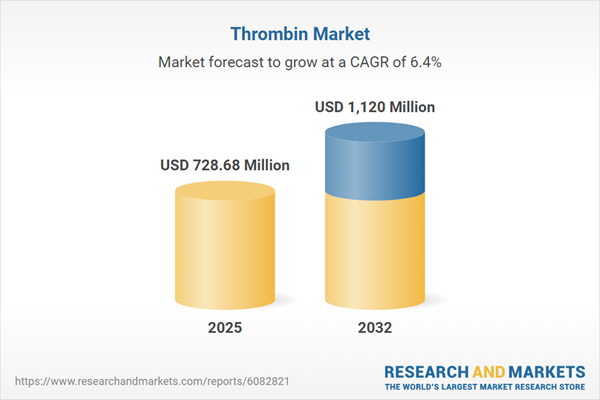Speak directly to the analyst to clarify any post sales queries you may have.
Senior leaders in healthcare and life sciences are witnessing a transformation in the thrombin market, driven by a surge in innovation and evolving priorities in hemostatic therapies. As organizations focus on advancing clinical outcomes and improving operational efficiency, adapting to these changes is becoming essential for sustainable success.
Market Snapshot: Thrombin Market Growth and Trajectory
The thrombin market, at a pivotal point globally, is experiencing steady expansion fueled by changing surgical protocols, regulatory developments, and the incorporation of advanced delivery solutions. In 2024, the market reached USD 685.05 million and is expected to grow to USD 728.68 million in 2025, reflecting a compound annual growth rate of 6.41%. By 2032, forecasts indicate potential revenues approaching USD 1.12 billion. This growth trajectory reflects widespread adoption of thrombin across diverse surgical settings and the sector’s resilient adaptation to emerging clinical requirements.
Scope & Segmentation
This executive-level analysis equips decision-makers with practical intelligence to strategize across critical dimensions of the thrombin market.
- Product Types: Analysis covers bovine thrombin, human thrombin, and recombinant thrombin, each with unique implications for immunogenicity, scalability, and regulatory approvals.
- Applications: Strategic insights span dental, cardiac, general, neurosurgical, orthopedic, and trauma procedures, demonstrating thrombin’s role in diverse clinical interventions.
- End Users: Findings highlight trends across ambulatory surgery centers, clinics, and hospitals, providing perspective on procurement patterns and operational requirements.
- Formulations: Assessment includes gel, liquid, and lyophilized powder forms, with a focus on solution storage, ease of administration, and suitability for various intraoperative settings.
- Distribution Channels: Coverage addresses the influence of direct sales, distributors, hospital pharmacies, and digital platforms, identifying avenues for targeted and broad market engagement.
- Geographical Coverage: Regional analysis spans the Americas, Europe, Middle East & Africa, and Asia-Pacific, reflecting unique regulatory landscapes, payer frameworks, and infrastructure capabilities.
- Company Analysis: Evaluation of leading firms—Baxter International, Johnson & Johnson, Pfizer, Takeda Pharmaceutical Company, Grifols, CSL Limited, Haemonetics, Ferring B.V., Becton, Dickinson and Company, and Merck KGaA—showcases a spectrum of go-to-market strategies and investment in innovation.
Key Takeaways
- Accelerated adoption of recombinant thrombin is enhancing product consistency and reliability, making it suitable for both large volume and niche clinical situations.
- Innovations such as gel-based matrices integrated with automated delivery systems enable less invasive procedures and contribute to efficient hemostasis when rapid intervention is necessary.
- Success in market entry and expansion hinges on aligning strategy with local infrastructure maturity and payer preferences to optimize competitive positioning.
- Strategic partnerships, mergers, and co-development opportunities are extending product pipelines and deepening competitive engagement among incumbents and new entrants.
- Facilities and procurement teams are adjusting priorities, with surgical centers emphasizing usability, clinics prioritizing cost management, and hospitals seeking adaptable product portfolios to meet evolving care demands.
Tariff Impact: Navigating 2025 Trade Shifts
Scheduled adjustments to the US tariff framework for 2025 have heightened operational costs for manufacturers dependent on imported active pharmaceutical ingredients. To mitigate volatility, organizations are investing in domestic production and partnerships with local suppliers, strengthening supply security. Payers are exhibiting increased cost sensitivity, leading to more assertive negotiations and shifting margin expectations. Digitalization of inventory, logistics, and procurement workflows is accelerating, enabling faster adaptation to fluctuating regulatory conditions and supply chain risks.
Methodology & Data Sources
The research employs a mixed-methods approach, combining executive interviews, quantitative manufacturer surveys, and a review of regulatory filings, academic literature, and customs records. This triangulated strategy ensures the accuracy, reliability, and relevance of insights delivered to market participants.
Why This Report Matters
- Enables leadership teams to navigate regulatory, technological, and regional transitions affecting adoption and supply of thrombin-based therapies.
- Delivers benchmarking and insight for informed decision-making in portfolio strategy, market entry, and partner selection.
- Supports investment and risk management by comparing key market segments and highlighting geographic opportunities and challenges.
Conclusion
Ongoing developments in the thrombin market are characterized by clinical innovation, adaptive supply models, and evolving delivery practices. Organizations prioritizing technology advancement, supply chain resilience, and collaborative strategy are positioned for strong performance within this dynamic sector.
Table of Contents
3. Executive Summary
4. Market Overview
7. Cumulative Impact of Artificial Intelligence 2025
Companies Mentioned
The companies profiled in this Thrombin market report include:- Baxter International Inc.
- Johnson & Johnson
- Pfizer Inc.
- Takeda Pharmaceutical Company Limited
- Grifols, S.A.
- CSL Limited
- Haemonetics Corporation
- Ferring B.V.
- Becton, Dickinson and Company
- Merck KGaA
Table Information
| Report Attribute | Details |
|---|---|
| No. of Pages | 182 |
| Published | November 2025 |
| Forecast Period | 2025 - 2032 |
| Estimated Market Value ( USD | $ 728.68 Million |
| Forecasted Market Value ( USD | $ 1120 Million |
| Compound Annual Growth Rate | 6.4% |
| Regions Covered | Global |
| No. of Companies Mentioned | 11 |









